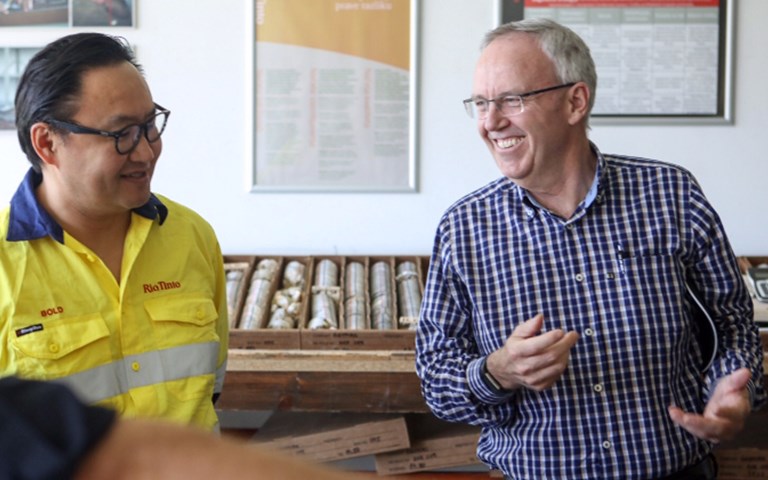Stephen McIntosh (right), group executive of growth and innovation at Rio Tinto, makes a site visit. Courtesy of Rio Tinto
Rio Tinto cleared an important hurdle this May when Australia’s railway regulator gave the go-ahead to the company’s automated rail project, which will carry iron ore from multiple mining operations to ports in the Pilbara region of Western Australia without personnel on the train. It is the latest milestone for the AutoHaul project, one piece of the now 10-year-old “Mine of the Future” program at Rio Tinto that has also seen the roll out of autonomous haul trucks and drill fleets, and the creation of the operations centre in Perth to control this growing automated workforce.
The lessons learned from these programs and the technological infrastructure put in place to manage them will be the backbone that supports the expansion of these technologies across the company’s network of operations, developments and as yet undiscovered projects around the world. It is Stephen McIntosh’s task as the lead of Rio Tinto’s Growth and Innovation group to manage this expansion and use evolving technologies to open up new frontiers.
The development of the Koodaideri iron ore project in the Pilbara, which the company has dubbed the “intelligent mine” and will decide this year if they are to set in motion, represents an important next step. “It’s digital from the ground up,” said McIntosh. Beyond the implementation of autonomous drilling, haulage and rail transport, “all of the designs are digital, and every single component of this is being built in a 3D model. When those have been constructed, those same models will become the twin for maintenance, to guide the safe and efficient operation of those assets.”
Autonomous technology and artificial intelligence will also be deployed in other aspects of operations. “Best practice in data science will underpin this type of mine – advanced data analytics, machine learning and control loop optimization will be embedded from the start,” he said. “We’ll ultimately be able to use external scans of haul trucks and other equipment to complement the operating data that is being generated by the spectrum of sensors on board these vehicles. If a component needs replacing, the new part can be sent to the maintenance bay and be on hand for the mechanics when the machine arrives for service – it’ll be data in real time and a paperless process.” Then, once repairs are complete, McIntosh said, “the mine automation system puts the vehicle back into the load-haul loop. That is really the first time you see the real future, when all of those technologies come together.”
Related: Caterpillar and Komatsu sign agreements with Rio Tinto to retrofit haul trucks with autonomous technology at company’s Pilbara operations
It also falls to him to replenish the company’s reserves with new discoveries. And this is a project where the role of advanced technology is still in its early days, though its potential is immense. McIntosh said the nearly 150-year-old miner has, after more than a decade of work, digitized the bulk of its historical information. It is serendipitous, he noted, that they finished the hard slog of data preparation at a time when artificial intelligence has begun to show such promise for explorers.
“Collectively we have over a hundred years of information in our archives spanning more than a hundred countries and a lot of it is unique to us,” he said. McIntosh cited the ability to improve exploration targeting as well as the ability to make quick and informed decisions in the field as the most potent weapons for geologists.
Now McIntosh, who began his career as a geologist in the 1980s, has the perspective to appreciate the moment the mining industry is now in and the enviable opportunity to stake out a new realm.
Discover more of our 2018 Names to Know




